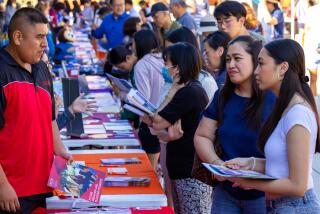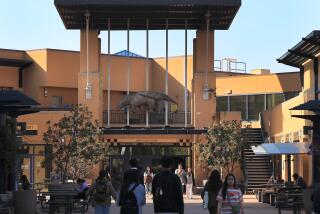College admission offers may get easier to obtain
After a long stretch of rising competition in college admissions, the numbers this year may be on the side of students like Davone Morales, an Eagle Rock High School senior. He and his classmates nationwide are lucky to be part of the smallest group in years applying to college.
The population dip won’t bust open the doors to Stanford, Harvard, UCLA and other highly selective campuses. But many experts predict it will be somewhat easier to obtain admission offers from many good, even competitive, schools. And colleges, particularly private ones that are not the top brand names, are working harder to court applicants, recruiting farther from their campuses and sweetening financial aid offers.
To students, the demographic dip offers a bit of hope after months of writing essays, taking entrance exams and gathering recommendation letters. This is crunch time for these seniors: University of California applications are due Saturday and the deadline for most private colleges is weeks later. Students typically don’t find out where they’ve been accepted until the spring.
The dip in applicants “may help you get into certain colleges except for the Ivy Leagues, but it’s still a really stressful time,” said Morales, who is applying to UC and California State campuses and such private schools as USC, Syracuse, George Washington and American to study broadcast journalism.
The numbers of high school graduates across the country rose from 2.6 million in 1996-97 to a peak of 3.4 million in 2010-11, as the children of later baby boomers matured into 12th-graders. Then a decline began and the low point will be this year’s 3.2 million nationally, according to a report by the Western Interstate Commission for Higher Education. The incoming college freshman pool may shrink further since Latinos comprise a rising portion of high school graduates but enroll in college at relatively low rates.
“Students and families are a little more in the driver’s seat than they were a few years ago,” said Brian Prescott, the Western Interstate official who co-authored the report, “Knocking at the College Door.” Chances will be somewhat better for students to be admitted to schools higher on their wish lists than older siblings faced, he said.
Although high school seniors believe they have a monopoly on anxiety, many colleges face uncertainty about filling a freshman class and getting enough tuition revenue, said David Hawkins, director of public policy and research at the National Assn. for College Admission Counseling.
“Historically, admissions officers are very sensitive to the fluctuation of the population of high school graduates and know that in lean times the level of competition among colleges for students tends to ramp up,” he said.
A recent survey of 381 colleges by the website Inside Higher Ed found unease in admissions offices: 76% of schools reported they were moderately or very concerned about meeting their new student enrollment goals and only 10% said they were not concerned at all.
The population decline is partly offset at some schools by a trend among students to apply to more colleges than previous generations, made easier by the online common application form. Additionally, many schools want to enroll more international students, particularly those who can afford to pay full tuition, experts said.
But many colleges still are upping U.S. recruiting by social media and visits to high schools.
The increased salesmanship was evident the last few months at Palisades Charter High School in Pacific Palisades, where more colleges visited than in the past, including such first-timers as the University of Kansas and the University of Illinois at Urbana-Champaign, according to college advisor Helene Kunkel.
“There are definitely more and more colleges sending people out on the road,” she said. That is particularly true of schools in regions like New England and the Midwest where populations have dropped more than in the West and South. Still, she urges students not to relax their application efforts and to cast a wide net for colleges, especially if they need financial aid.
Palisades senior Karina Duarte worried that any demographic advantage could disappear if more applicants decide to try their luck at the most prestigious colleges.
Still, Duarte, who is applying to about 10 schools, including several UC campuses, Kalamazoo College in Michigan, Boston University and Mills College in Oakland to study biochemistry, said she hopes the population decline helps “a tiny bit because maybe the colleges will take more time to read my application.”
At Kalamazoo, a well-regarded liberal arts college, administrators got an early taste of population decline with exoduses from Michigan cities over the last decade. After expanding recruiting and advertising, out-of-state freshmen doubled in the last decade to 38%, according to Eric Staab, the school’s dean of admission and financial aid.
“More schools are having to offer admissions to more kids,” he said. But the effect will be uneven depending “on where the college is located and what kind of footprint it has nationally.”
In California, the number of high school seniors is expected to be about 3.5% smaller this year than last, according to the state Department of Education. However officials at the University of California say it will not be any easier for them to get into the most in-demand campuses even though the annual growth in applications overall may slow. UC is recruiting more in both rural and urban communities in California and in other states and countries.
“It’s going to be as competitive as always. We have an embarrassment of riches with all these strong students doing very impressive things,” said Youlanda Copeland-Morgan, UCLA’s associate vice chancellor for enrollment management.
For its current freshman class, UCLA attracted the most applications — nearly 80,500 — of any public university in the nation and accepted only 20%. Ivy League schools and some other prestigious colleges accept even fewer students. Admissions experts, however, say families should not be overly concerned about such low acceptance rates since it is easier to get into othergood schools.
At a recent college fair sponsored by the Los Angeles Area Chamber of Commerce at the L.A. Convention Center, several thousand high school students crowded around recruiters from local and out-of-state colleges.
At the table for the University of San Francisco, a private Catholic campus, admissions official Suzette DeGrange said her school is well aware of the demographic change and is reaching out more strongly to high school seniors, as well as to transfers from community colleges and older adults.
“It’s a great time, I think, to be a high school student, and to dream and to reach for those schools they might not have considered in the past,” she said. “More doors absolutely will be open for students nationally.”
larry.gordon@latimes.com
More to Read
Start your day right
Sign up for Essential California for news, features and recommendations from the L.A. Times and beyond in your inbox six days a week.
You may occasionally receive promotional content from the Los Angeles Times.







